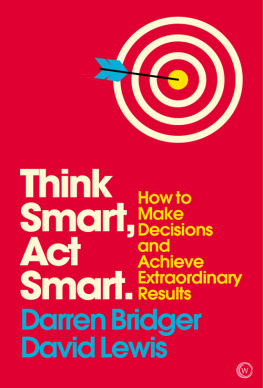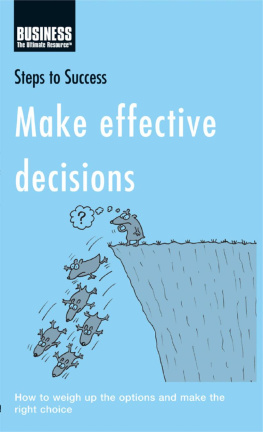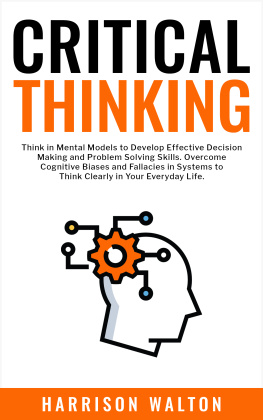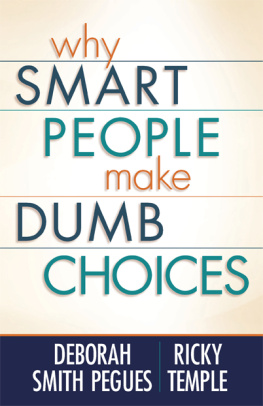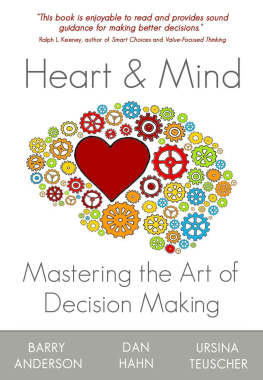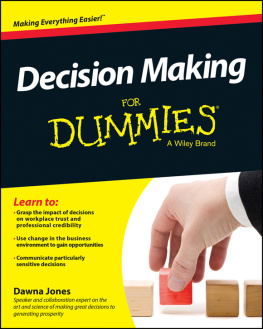THINK SMART,
ACT SMART
In any moment of decision the best thing you can do is the right thing, the next best thing is the wrong thing, and the worst thing you can do is nothing.
Theodore Roosevelt (18581919)
Darren Bridger & David Lewis
THINK SMART, ACT SMART
How to Make Decisions and
Achieve Extraordinary Results
CONTENTS
INTRODUCTION
Every day we analyze situations, tackle problems, make choices, take decisions, act upon them. This book shows you how to do all of these things better. Well explain how to use techniques developed by psychologists, mathematicians, business consultants, sports competitors and even military strategists. There are mind-training exercises and self-assessments, as well as background information to inform and entertain. All of these tools can help you to use your mental powers more effectively.
FACING CHALLENGES
Occasionally, a situation will demand an instant response if we see a poisonous snake in our path, we dont spend a lot of time weighing up options! But most situations are much more complex than this, and demand a variety of reasoning skills. Even an everyday decision such as choosing a vacation can involve a surprisingly complex process: estimating risks, weighing up options, considering the needs of others, and predicting how we might feel in different locations.
Sometimes, an area of life work, family life or even leisure time can give rise to problems that can be difficult to tackle or solve. You might find that you cant manage a situation effectively with your usual strategies, or even that it presents you with an entirely new dilemma. In these circumstances, you might well need extra mental tools. This book will guide you through every stage of a challenge, so that you can work your way to an appropriate conclusion.
FOCUSING YOUR MIND
As a starting point, youll need a variety of mental skills to help you analyze the situation. First, you need to be able to focus to use your mind like a camera to obtain the best view of the problem. There are times when your focus will have to be pin-sharp, but at other times you may need to take a wide-angle view, or to adjust your thinking so that you look deeper into the background of an issue. The first two chapters show you different ways in which you can draw on both logical reasoning and more creative, intuitive thought, so that youll be able to cope successfully with a wide range of situations.
DECISIONS, DECISIONS
Every choice brings unique opportunities, but also costs: for every option that you take, there will be one or more others that you have to reject. The worry about making the right choice, or the suspicion that a discarded option might actually have been better, can make decisionmaking fraught with anxiety and lead to regret.
You can do one of two things when decision-making: exhaustively consider every possible choice in the quest for the perfect answer, or search just until you find a good enough option. In confining yourself to looking for the perfect answer, theres a risk that you might expend a disproportionate amount of time and energy, and perhaps still not attain your ideal, when all you need is simply a workable solution.
The more elements there are for you to weigh up in your mind, the more skilful youll need to be to narrow down your options to a precise course of action. You may have to take into account all kinds of conditional factors youll do X if this happens and Y if that happens but without a clear set of steps that can lead you to a decision, its easy to become entangled in a web of confusion.
Making these choices may at times seem like hard work, but the alternative is worse: as the philosopher Bertrand Russell wrote, Nothing is so exhausting as indecision. And nothing is so futile.
THINKING STRAIGHT
Effective decision-making doesnt always come naturally. However, it can be learnt and improved. To start with, you need a clear perception of the facts: if you fail to check your assumptions, then no matter how good your reasoning, you could be misguided. Youre equipped with a range of inbuilt reflexes, emotional responses and reasoning skills, which are often useful but can sometimes lead to errors of thinking. By learning how to recognize and avoid these biases, you can keep your mind clear and your perceptions accurate.
offers a wealth of practical guidance.
A samurai was traditionally supposed to be able to arrive at any decision within the space of seven breaths. While you might not achieve or even need such clarity, with the help of this book you can discover the benefits of sharper, more assured decision-making.
TIME FOR ACTION
Some people spend an inordinate time analyzing situations without ever making concrete decisions; others make good decisions but then fail to act on them. Procrastination, flagging motivation and waiting for the right moment can all prevent us from taking action. So can fear: fear of the consequences (many reasonable and valid actions have a downside), fear of change, or fear of others reactions.
Do you want to know who you are? Dont ask. Act!
Thomas Jefferson (17431826)
To overcome these obstacles and turn your decisions into effective action, youll need to define a clear goal, have a well-crafted plan of action, manage your time efficiently, and break out of inertia to create a new habit of action. By mastering these necessary skills, youll be able to achieve your objectives as easily and effectively as possible.
STRETCH YOURSELF
Whether you wish to work through the whole book or simply dip into sections that interest you, we hope that youll find this a fascinating, enlightening and instructive practical guide to the most valuable tool you have at your disposal your own mind. Your resources and your potential capabilities go far beyond what you might imagine. Learn to stretch yourself a little: youll never regret it!
1
FOCUS AND CONCENTRATION
To tackle any decision or take any action, its essential for you to be able to focus your thinking effectively. However, narrow, singleminded concentration isnt the best option in every situation. This chapter shows you how you can benefit from changing mental gear to respond to different circumstances. There are exercises to help you discover your preferred style of thinking, and to teach you how best to use both analytical and creative thinking to get results. Lastly, there are guidelines on multi-tasking and on setting priorities for your activities.
FOCUSING EFFECTIVELY
Problem-solving, decision-making and action all need to start with the right level of focus. To tackle all the possible aspects of a project or plan, youll need to be able to switch between different types of focus, from constructive daydreaming to intense concentration.
THE FOUR LEVELS OF FOCUS
The mind has four main levels of focus, a bit like the gears of a car. These levels result from different patterns of brain activity, which are described opposite. You naturally make use of all four, but its also possible for you to change gear consciously.
Changing down
To drop down to gears 2 or 1, find somewhere you wont be disturbed, close your eyes lightly and relax. Keep your breathing slow and deep, at four breaths per minute for 60 seconds. The most helpful situations include taking a bath or shower, walking, or sitting or lying down. Slow, soothing music will help you change down to first gear.
Next page
